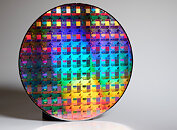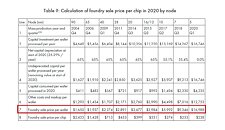Thursday, September 17th 2020

Alleged Prices of TSMC Silicon Wafers Appear
TSMC, one of the biggest silicon manufacturers in the world, usually doesn't disclose company pricing of the silicon it manufactures and only shares that with its customers. It appears that RetiredEngineer (@chiakokhua on Twitter) got a hold of the pricing of TSMCs wafers on every manufacturing node starting from 90 nm down to 5 nm. That includes a wide portfolio of 65, 40, 28, 20, 16/12, 10, and 7 nm nodes as well. The table shown below includes information dating to April 2020, so it is possible that some things are now different and they surely are. There are a few quite interesting notes from the image, namely the price increase as the node shrinks.
From 90 nm to 20 nm, the price of the wafer didn't increase as much, however, starting from 16/12 nm node(s), TSMC has seen costs per wafer, and other costs increase exponentially. For example, just compare the 10 nm wafer price of $5992 with the price of a 5 nm wafer which costs an amazing $16988. This is more than a 180% price increase in just three years, however, the cost per transistor is down as you get around 229% higher density in that period, making TSMC actually in line with Moore's Law. That is comparing Transistor density (MTr / mm²) of52.51 million transistors for the 10 nm node and 173 million transistors per mm² of the 5 nm node .
Source:
@chiakokhua (Twitter)
From 90 nm to 20 nm, the price of the wafer didn't increase as much, however, starting from 16/12 nm node(s), TSMC has seen costs per wafer, and other costs increase exponentially. For example, just compare the 10 nm wafer price of $5992 with the price of a 5 nm wafer which costs an amazing $16988. This is more than a 180% price increase in just three years, however, the cost per transistor is down as you get around 229% higher density in that period, making TSMC actually in line with Moore's Law. That is comparing Transistor density (MTr / mm²) of52.51 million transistors for the 10 nm node and 173 million transistors per mm² of the 5 nm node .


11 Comments on Alleged Prices of TSMC Silicon Wafers Appear
Certainly being on advanced node is costly. The 16/12 seems a sweet spot and probably is the reason why Nvidia used it through 2019 and half of 2020 and the 7NM being double the price why they went for 8nm Samsung.
Also means that Big Navi can not be a cheap card in order to obtain at least decent margins unless AMD, becoming a major customer, can negotiate healthy discounts.
81mm^2: 668 fully working chips out of 724, $25.45 each
100mm^2: 526 / 581, $32.32 each
Zen 4 is likely to be on 5nm - assuming that it retains an 8C CCD, but with 64MB L3 and larger CPU cores, it will be close to that 81mm^2 mark. With 32MB still it could be closer to 64mm^2, 866 dies / 922 @ $19.60 each (but wafer price will have dropped by 2022)
AMD just doesn't have any margin to compete with RTX 3070/3080 at this point, they may just release a limited quantity of Big Navi just to stay relevant.
The Xbox GPU with 56CU is less than 180mm² and the Navi with 80CU is 500mm² ? How ? Where did you get those numbers? I hope you haven't just doubled the size of the Navi10 (250mm² x 2)...
And no AMD is only a minor customer of TSMC, they dont get any special treatment regarding wafer prices, biggest customer is Apple.
80CU plus 512bit bus mem controller and specialized RT cores, kinda hard to imagine Big Navi is much smaller than 500mm2, unless they don't want to compete with 3070 at all.
The information that is missing from the article is what is the size of the wafers, TSMC typically has 150mm, 200mm, and 300mm ones.
It's impossible to tell at this point in time. Now seems like as compelling a time as any to make a strong push at advancing CF and mGPU setups between PCIe 4.0 having excess bandwidth to readily and easily devout to it and with variable rate shading plus HBCC along with infinity fabric provides ample amounts of leeway to work around and address some of those mGPU micro stutter problems. It could a case in the future that with mGPU you just tweak a few variable rate shader settings and you can smooth out mGPU micro stutter in major ways. Either way this is a compelling generation of GPU upgrades between things like RTRT and variable rate shading and other things. I really hope AMD has a ace up it's sleeve and makes some big advancements in area's hopefully they've improved compression a lot Nvidia's made a lot more inroads in that area in recent years. The more competitive it is between both companies the better it is for consumers. I'm just hoping they have a unexpected surprise thrown in someplace.
the image says CALCULATED, the source says RIGOROUS ESTIMATES (further saying based on a report that was shown to him)